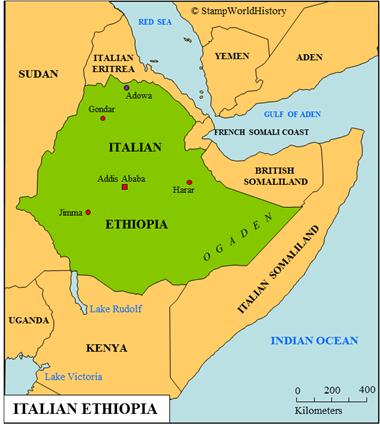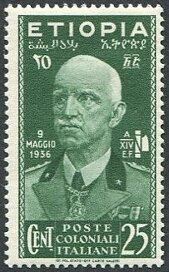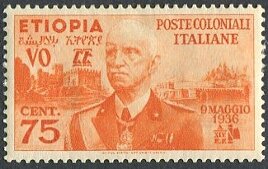
Italian Ethiopia
Quick reference
General issues: Italian colony 1936
Country name on general issues: Etiopia
Currency: 1 Lira = 100 Centesimi
Population: 16 859 000 in 1935
Political history Italian Ethiopia
Ethiopia is located in eastern Africa. The population consists of Afro-Asiatic peoples of which several also live in neighboring countries. Ethiopia has a long history. The last imperial dynasty traced its roots to 950 BC. The modern history of Ethiopia begins in the mid 19th century. Having fallen apart in the mid 18th century, Ethiopia is once again unified under imperial rule and modernized using European advisers.
Italy is late to join the European powers in their race for the establishment of colonies. In the late 19th century, Italy establishes itself in Italian Eritrea and Italian Somaliland. The ultimate ambition – the colonization of Ethiopia – is thwarted in 1896 when Ethiopia decisively defeats Italy in the battle of Adowa. At the height of the colonial ‘Scramble for Africa’, the empire of Ethiopia is one of the two countries on the African continent to retain its independence.
The ambition to colonize Ethiopia is revived under the fascist regime of Benito Mussolini. In 1935, Italy again invades Ethiopia and this time Italy comes out victorious. Although the Ethiopian emperor Heile Selassie made an adamant appeal to the League of Nations to condemn the Italian aggression, Ethiopia is annexed as an Italian colony in 1936. King Victor Emanuel III assumed the title of emperor of Ethiopia. The existence of Italian Ethiopia as a separate political entity is short lived: annexed in May 1936, Ethiopia is made part of Italian East Africa in June 1936, together with Italian Eritrea and Italian Somaliland.
Just after the outbreak of WWII, the British, in 1940, invade Italian East Africa and in 1941 the Italian administration capitulates. After a short period of British military administration Ethiopian sovereignty is largely restored in 1942.
Postal history Italian Ethiopia
The first postal services to exist in Ethiopia are the offices abroad of Britain, Egypt and France. A domestic postal service is set up, from 1894, through a concession that is granted to a European adviser that has risen to the level of minister at the imperial court. The imperial government takes over the postal service in 1908.
The Italians, after the annexation of Ethiopia, have issued one set of stamps for Italian Ethiopia to commemorate the ascension of Victor Emanuel III to the imperial throne of Ethiopia. Part of the set is issued in May 1936, part in December 1936. Otherwise, the stamps of Italian Eritrea and Italian Somaliland came to be used widely in Ethiopia from 1936. All these were superseded by the issues for Italian East Africa from 1938 – issues that would be used until 1941.
After a short period of using British stamps, while under British administration, Ethiopia resumes issuing stamps in 1942.
Album pages
← Previous page: Italian EritreaNext page: Italian Jubaland →




